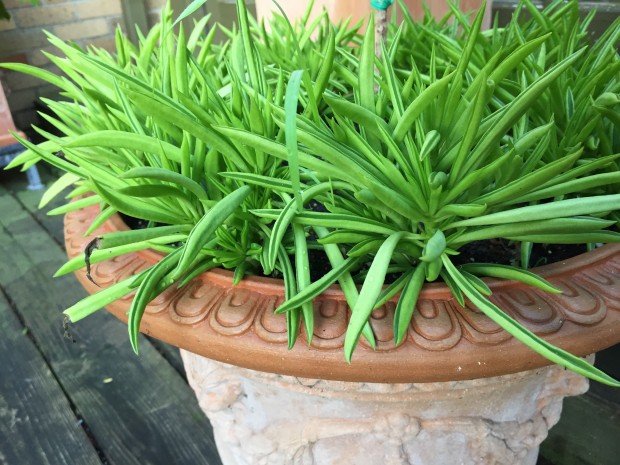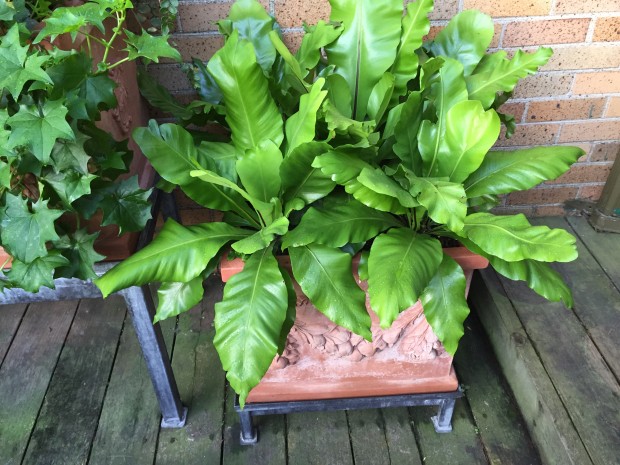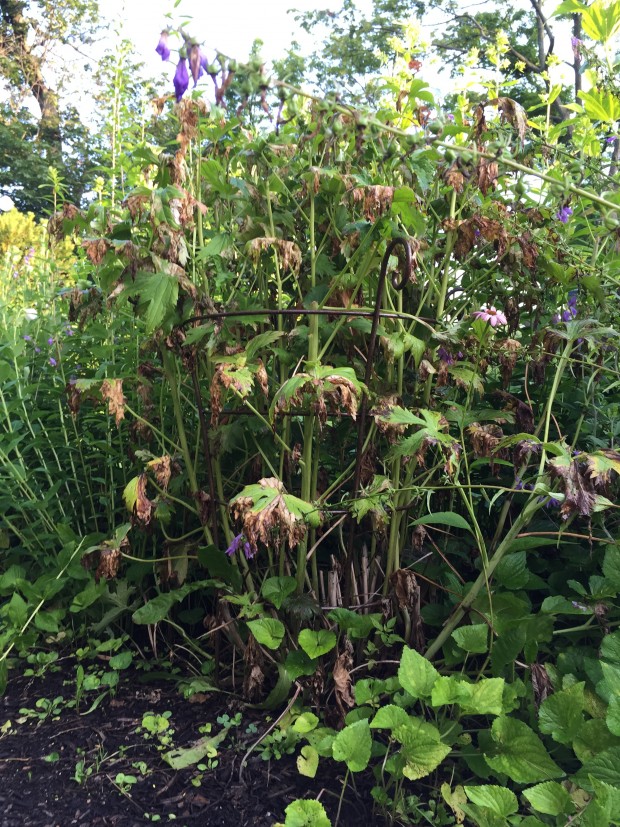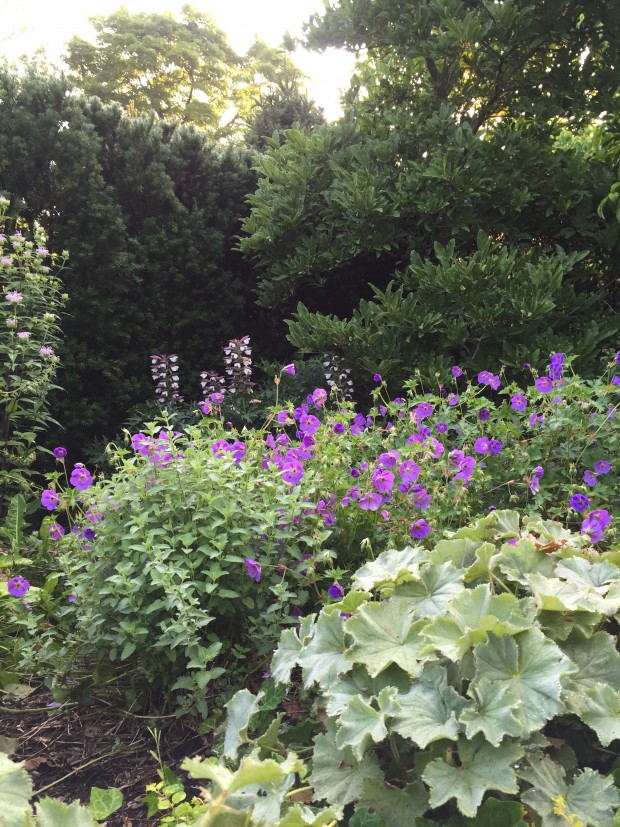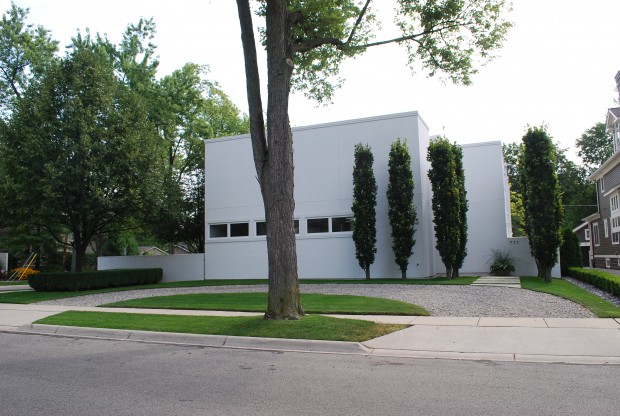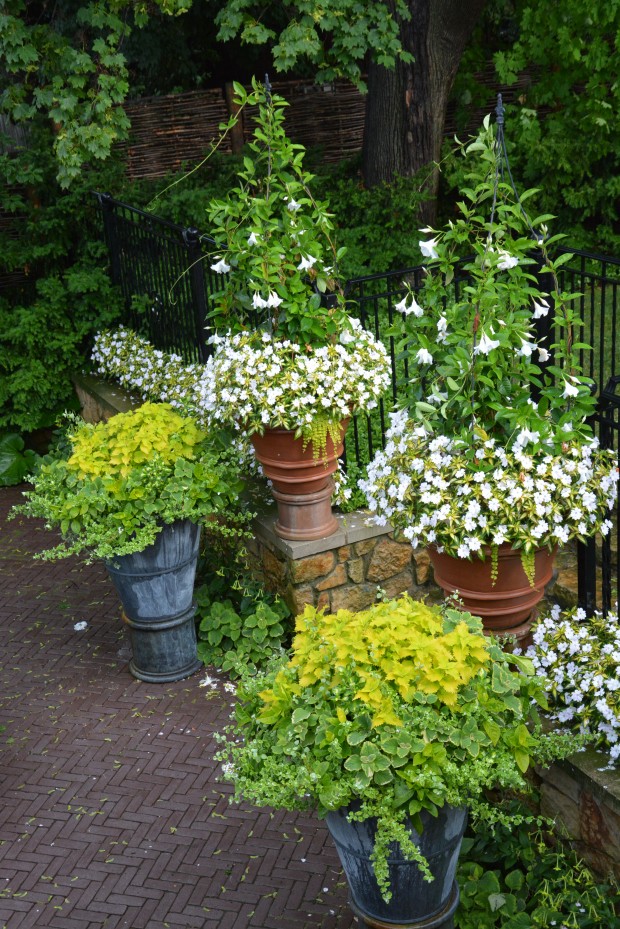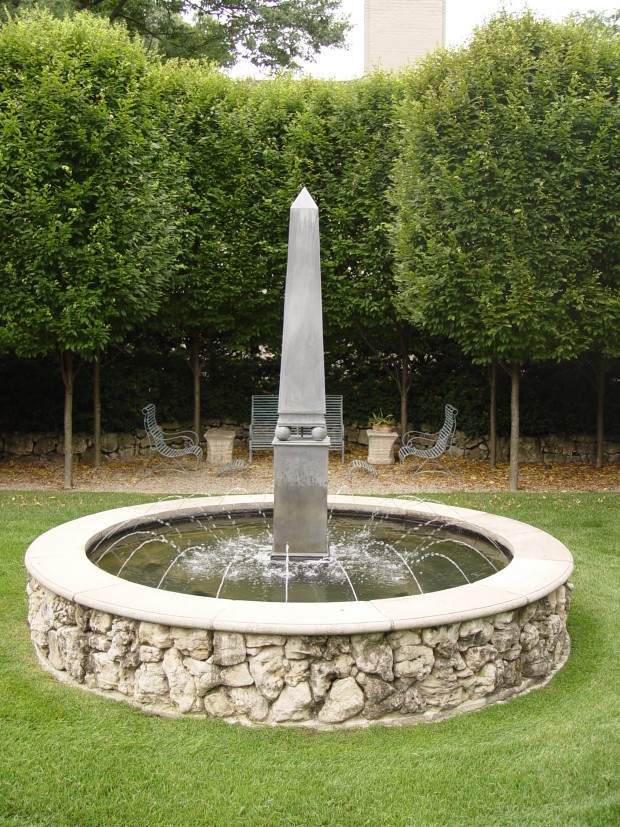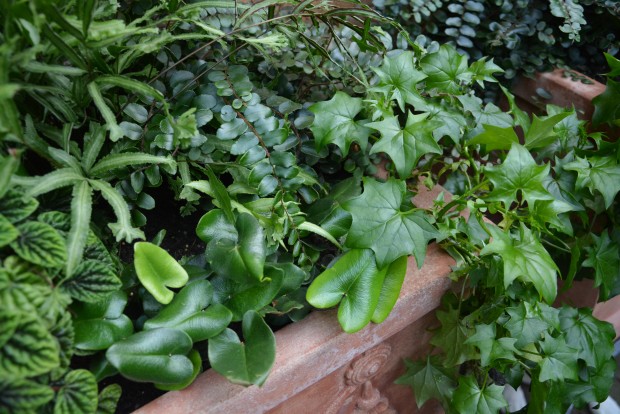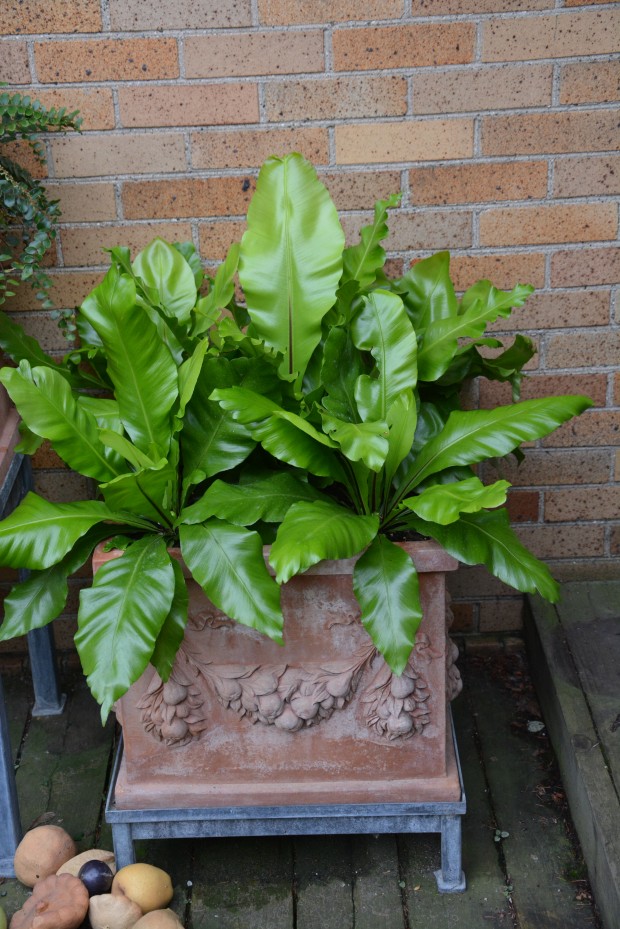 Last September I consulted with a client who had just purchased a jewel of an old home on a small property. Extensive renovations to the interior were just about done. The existing garage had been enlarged, and a living space above it has been added. The neighborhood is lovely. All of the homes are in close proximity. They had gone so far as to install a new blue stone walk to the front door. A new landscape plan had been proposed, but she was hesitant about it. My advice to anyone seeking the services of a designer is as follows. If you have any reservations, sort them out before there is any arrangement to start the work. Right off the bat, I loved the lollipop crab apples in front, but I disliked how they covered the beautiful bow windows, and the view to the outside. Plants do grow. A good designer will site plants such that they do not grow into the elephants in the front yard.
Last September I consulted with a client who had just purchased a jewel of an old home on a small property. Extensive renovations to the interior were just about done. The existing garage had been enlarged, and a living space above it has been added. The neighborhood is lovely. All of the homes are in close proximity. They had gone so far as to install a new blue stone walk to the front door. A new landscape plan had been proposed, but she was hesitant about it. My advice to anyone seeking the services of a designer is as follows. If you have any reservations, sort them out before there is any arrangement to start the work. Right off the bat, I loved the lollipop crab apples in front, but I disliked how they covered the beautiful bow windows, and the view to the outside. Plants do grow. A good designer will site plants such that they do not grow into the elephants in the front yard.
 A beautiful sun room was faced down by yews and boxwood that were not doing well, a kousa dogwood which was obviously unhappy, and a random collection of knockout roses. The bed line seemed out of touch with the arrangement of plants. Idea 2: if you have bed lines in mind, cut them before you plant, and arrange the plants to repeat that line. If you plant before you have a bed scheme in mind, your job is tougher. You may need to plant a series of plants that reinforce the shape you have established. Bed lines are a very powerful visual force in a landscape. I always set them first, before I go on to a planting scheme.
A beautiful sun room was faced down by yews and boxwood that were not doing well, a kousa dogwood which was obviously unhappy, and a random collection of knockout roses. The bed line seemed out of touch with the arrangement of plants. Idea 2: if you have bed lines in mind, cut them before you plant, and arrange the plants to repeat that line. If you plant before you have a bed scheme in mind, your job is tougher. You may need to plant a series of plants that reinforce the shape you have established. Bed lines are a very powerful visual force in a landscape. I always set them first, before I go on to a planting scheme.
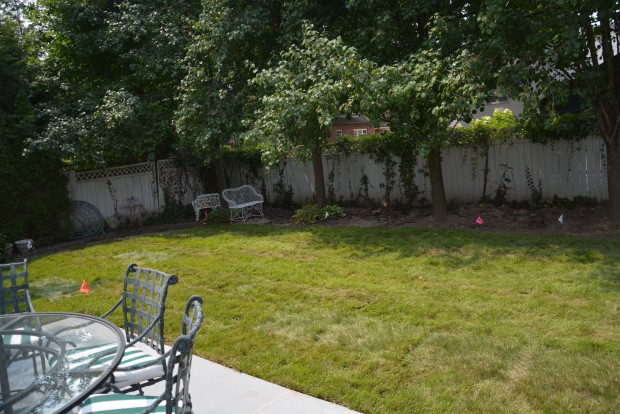 The back yard had a privacy fence, and a row of bradford pears. The trees had not been tended to much in recent years, and were in poor condition. A new blue stone terrace had been set at the correct height out the rear doors. The ground dropped dramatically to the fence line. I spent a lot of time looking over those trees. Could they stay? My clients previous landscape proposal called for keeping these trees. My clients were happy with the neighborhood, but wanted some privacy in the rear yard. But these trees?
The back yard had a privacy fence, and a row of bradford pears. The trees had not been tended to much in recent years, and were in poor condition. A new blue stone terrace had been set at the correct height out the rear doors. The ground dropped dramatically to the fence line. I spent a lot of time looking over those trees. Could they stay? My clients previous landscape proposal called for keeping these trees. My clients were happy with the neighborhood, but wanted some privacy in the rear yard. But these trees?
 Landscapes can get away from a property owner so fast. Plants die from this or that. Trees deteriorate. Other trees grow out with abandon-the result not so desirable. There are gaps, and spaces that contribute to a weary and untended look. My client brought lots of treasured garden ornament with her to this new home. They needed a home.
Landscapes can get away from a property owner so fast. Plants die from this or that. Trees deteriorate. Other trees grow out with abandon-the result not so desirable. There are gaps, and spaces that contribute to a weary and untended look. My client brought lots of treasured garden ornament with her to this new home. They needed a home.
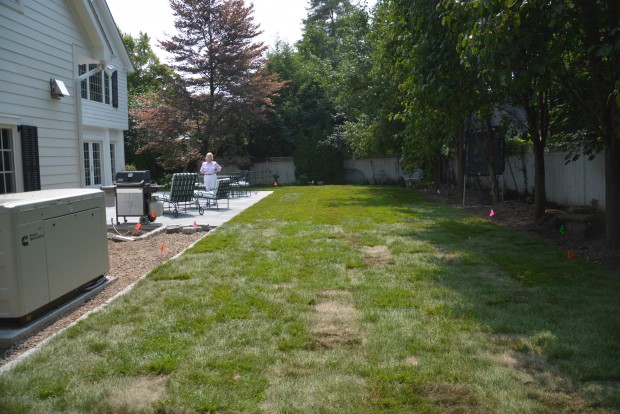 A new lawn went a long way to banish the blues. But the space was asking for a landscape that was beautiful, and functional. Small properties are great for lots of reasons. I love that my city lot and a half is manageable. But a small space means there is no room to fudge. Every square foot needs to be part of a plan that works. A good designer listens to a client-first and foremost. They need to design to the client they represent. Occasionally they need to step out, and suggest a different approach. Next a designer, or a gardener designing for themselves, needs to draw the landscape from edge to edge. That drawing is a benchmark. The reality is where the spade meets the dirt. What works out on paper needs a sure hand to interpret the intent of the benchmark, once the landscape is being laid out, or underway.
A new lawn went a long way to banish the blues. But the space was asking for a landscape that was beautiful, and functional. Small properties are great for lots of reasons. I love that my city lot and a half is manageable. But a small space means there is no room to fudge. Every square foot needs to be part of a plan that works. A good designer listens to a client-first and foremost. They need to design to the client they represent. Occasionally they need to step out, and suggest a different approach. Next a designer, or a gardener designing for themselves, needs to draw the landscape from edge to edge. That drawing is a benchmark. The reality is where the spade meets the dirt. What works out on paper needs a sure hand to interpret the intent of the benchmark, once the landscape is being laid out, or underway.
 The over anxious landscape company before me sheared the backs off of these trees, with the idea that arborvitae would be planted under the power lines. I will say I have never seen this done before. I believe this is why my client contacted me. I could not imagine how trees in poor health to begin with would take to this kind of pruning. Nor did I believe arborvitae would prosper in the one wedge of sun they would get at noon every day.
The over anxious landscape company before me sheared the backs off of these trees, with the idea that arborvitae would be planted under the power lines. I will say I have never seen this done before. I believe this is why my client contacted me. I could not imagine how trees in poor health to begin with would take to this kind of pruning. Nor did I believe arborvitae would prosper in the one wedge of sun they would get at noon every day. Once the Bradfords were gone, it became obvious that the wood fence needed repair. We shored up the leaning panels, and covered the deteriorated pickets at the bottom with a new cedar reinforcing board.
Once the Bradfords were gone, it became obvious that the wood fence needed repair. We shored up the leaning panels, and covered the deteriorated pickets at the bottom with a new cedar reinforcing board.
 Of course we painted the fence. That was easy and fast, given we had no obstructions to work around.
Of course we painted the fence. That was easy and fast, given we had no obstructions to work around.
 The garage wall was big, and bare. A trellis panel from the previous owner was set in the corner, to hide the electric service. My client placed her charming lead fountain in front of the wall. Charming as it is, the wall overwhelmed it. This wall needed a new idea. And the fountain needed a smaller more intimate location.
The garage wall was big, and bare. A trellis panel from the previous owner was set in the corner, to hide the electric service. My client placed her charming lead fountain in front of the wall. Charming as it is, the wall overwhelmed it. This wall needed a new idea. And the fountain needed a smaller more intimate location.
 A generator is a big appliance which is not so great looking. In a small yard, they seem gigantic. The idea to celebrate it with a giant graveled area edged in granite block did not seem like such a great idea. Both the wall and the generator area needed some green relief.
A generator is a big appliance which is not so great looking. In a small yard, they seem gigantic. The idea to celebrate it with a giant graveled area edged in granite block did not seem like such a great idea. Both the wall and the generator area needed some green relief.
 Once my client approved the new plan, we set the bones of the front yard. We added a small gravel path from the walk to the drive. And we designed a large steel pergola some 20 feet long which would be a better scale for the house. The new pergola would balance the sun room on the opposite side. The older wood arbor would be completely refurbished, and relocated to the entrance of the smaller and more intimate rear yard. That structure will be beautiful in a space where it can be better appreciated.
Once my client approved the new plan, we set the bones of the front yard. We added a small gravel path from the walk to the drive. And we designed a large steel pergola some 20 feet long which would be a better scale for the house. The new pergola would balance the sun room on the opposite side. The older wood arbor would be completely refurbished, and relocated to the entrance of the smaller and more intimate rear yard. That structure will be beautiful in a space where it can be better appreciated.
 We did replace winter damaged yews, and boxwood. We added more boxwood, in a formal square. Between the boxwood and the yews at the sidewalk-a row of Little Lime hydrangeas. The new front landscape is respectful of the beautiful concolor firs, arborvitae, and the low wall at the walk. We were underway with the renovation.
We did replace winter damaged yews, and boxwood. We added more boxwood, in a formal square. Between the boxwood and the yews at the sidewalk-a row of Little Lime hydrangeas. The new front landscape is respectful of the beautiful concolor firs, arborvitae, and the low wall at the walk. We were underway with the renovation.




